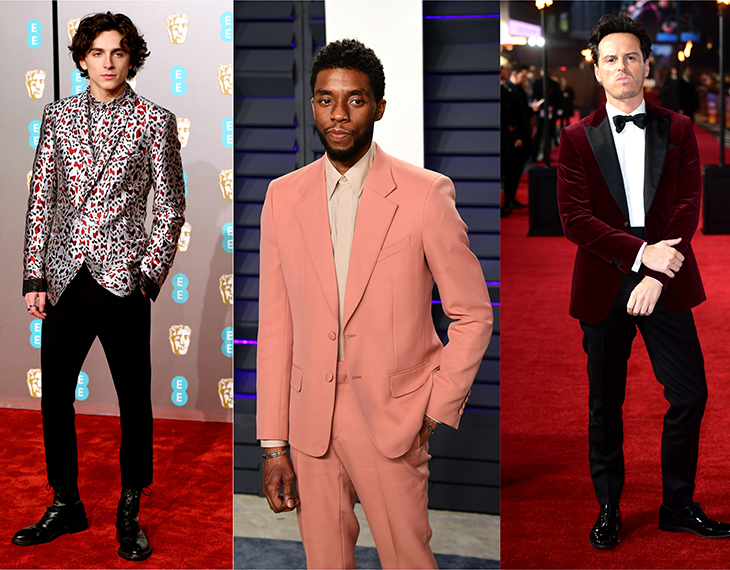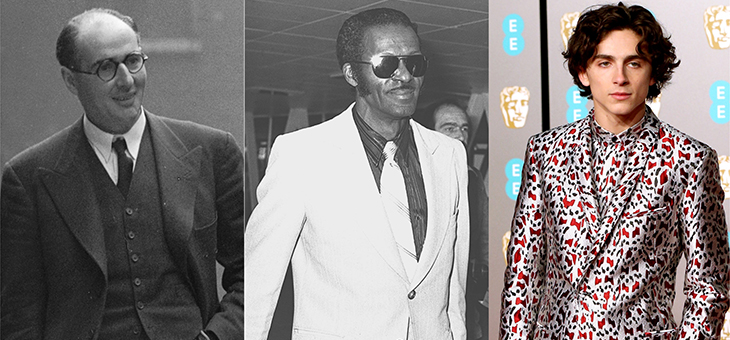Normally, womenswear gets all the attention – but that doesn’t mean we should forget about menswear altogether.
In fact, the humble suit is one of the hardest working outfits in fashion, and has seen countless reincarnations over the years.
The invention of the modern suit is often credited to Beau Brummell, a trendsetting dandy from the early 1800s. He encouraged high society to do away with the flouncy frock coats and powdered wigs of the 18th century, in favour of more streamlined, simple tailoring – similar to the style we know today, albeit with tails, riding boots and a cravat.
Read more: Kurt Russell and Goldie Hawn’s best style moments
Since then, the suit has taken a life of its own. Wearing a fully tailored look might not be an everyday occurrence for many of us, but it’s still experiencing new and different trends.
Most men ditched long jackets by the early 1900s, and this is how the suit progressed from there.
Peaky Blinders

You might recognise the heavy suits of the early 1900s from the popular TV show Peaky Blinders. Tommy Shelby and his brothers wear styles typical of the time: three-piece suits in heavy, workmanlike materials.
These were fairly utilitarian outfits, with slim-fitting jackets in muted tones, such as black, navy or dark brown.
The Roaring Twenties
While the working classes stuck to Peaky Blinders-style suits throughout the 1920s, it was a different story for those with money.
This was a time of excess – think of The Great Gatsby – so drab suits just wouldn’t do. Men increasingly wore tuxedos with white waistcoats for parties, or sharply tailored suits in softer, more expensive materials during the day. In this interwar period, fashion was a way of showing off how much money you had.
1940s minimalism

Inevitably, this shifted when WWII hit. Wool was in short supply, so suit manufacturers started experimenting with synthetic blends. Styles became more pared back; colours were dark, and patterns were subtle herringbones or pinstripes.
Even though suits were tailored, trousers were nothing like the slim fits we’re used to today. Instead, pants were relatively loose, with a sharply ironed crease down the front.
Zoot suits
Fashion trends are rarely neatly chronological. While the 1940s saw a more minimalist take on tailoring, it also saw the continued rise of zoot suits. Everything about this style was exaggerated: trouser legs ballooned out and were pegged at the bottom, lapels were wide and shoulders were padded up high. The look was often topped off with a large pork pie hat and shiny dress shoes.
Read more: The secret to folding a suit jacket when packing
Starting in Harlem in the 1930s, the trend was popular among the African American and Latinx communities, and became a hot button issue in the 1940s. As zoot suits required a lot of material to make, they were condemned by the mainstream as unpatriotic during wartime shortages.
The style became illegal in some areas of the US, and riots took place in 1943, where soldiers and sailors targeted Mexican Americans in LA wearing zoot suits. They became a symbol of protest or rebellion, with historian Kathy Peiss saying: “For those without other forms of cultural capital, fashion can be a way of claiming space for yourself.”
Mad Men
After the mainstream minimalism of the 1940s, the 1950s and ’60s saw suits gain a bit more style. This was the era of Don Draper and Mad Men, where many men had to wear a suit to work every day.
Styles were clean-cut and well-tailored, paired with slim ties and the occasional waistcoat. There were more opportunities to play around with patterns and colours, from pastels to a bright houndstooth.
1970s disco
Things changed once again in the ’70s, where vibrancy was the name of the game. Colours were bright and wild, lapels were huge, waists were high, legs were flared – think of John Travolta in Saturday Night Fever.
Suits saw experimentation like never before, with patterns, colours and ruffles taking over.
Oversized styles
After the excess of the ’70s, suiting saw a bit of a downturn. Other than the occasional pastel suit with rolled up sleeves, the 1980s and 1990s saw much more low-key styles: colours became muted and muddy, and tailoring went out the window.
During this time, suits were often oversized and looked almost misshapen. This wasn’t exactly the coolest time for men’s fashion, particularly as looks were paired with wide, funkily patterned ties.
The suit today

Luckily, men have become reacquainted with their tailor and you’re unlikely to see a baggy, ill-fitting suit on the red carpet. By the 2000s, suits became simpler, chicer and more streamlined.
Read more: Seven style lessons we’ve learnt from Mick Jagger
In recent years, men have started injecting their own personality into tailoring. Think of Michael B. Jordan wearing a Louis Vuitton harness on the red carpet, Timothee Chalamet in a statement patterned blazer and matching shirt, Chadwick Boseman in a pale pink suit or Andrew Scott wearing red velvet. Particularly as fashion becomes more gender fluid, the options for new suit styles seem vaster than ever.
Tailoring might feel worlds away from the relaxed pandemic fashion many of us have become used to, but who knows? Maybe the pendulum will swing the other way as we return back to normal, and suits will be back with a vengeance.
What’s your favourite style of suit? How often do you wear one?
– With PA
If you enjoy our content, don’t keep it to yourself. Share our free eNews with your friends and encourage them to sign up.






